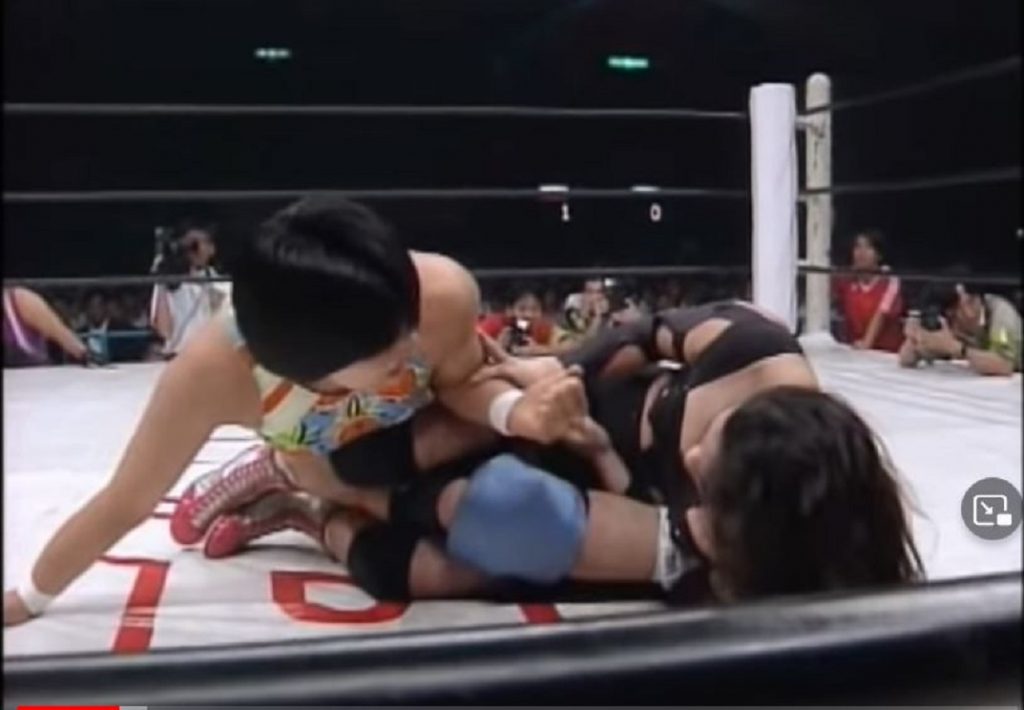On this day, the thunder queen battle in Yokohama took place. July 31st, 1993, bore witness to one of the greatest and most unique wrestling matches of all time.
First, imagine a traditional four-on-four Survivor Series tag match. Then add an ironman stipulation to it and make it go sixty minutes.
Then add some special stipulations during the first act. And finally, add eight of the toughest and most talented women’s wrestlers of all time as its participants. This is the story of the Thunder Queen Battle in Yokohama.
Writing out all of their names wouldn’t roll off the tongue that well, so let’s just call this match by the event it took place on.
It’s the Thunder Queen Battle in Yokohama, produced by Joshi JWP Joshi Puroresu.
The Thunder Queen Battle in Yokohama –
The Background
This wasn’t just a four-on-four tag team match; it was an inter-promotional four-on-four tag team match. It pitted four of the top wrestlers in JWP against four of the top women in All Japan Women’s Pro-Wrestling (AJW).
JWP was a splinter promotion that formed after a mass exodus of women from AJW. They were upset with AJW’s strict internal rules and decided to form their own company.
But instead of being upset or ignoring the new kids on the block, AJW decided that there was money to be made from all of this. Thus, AJW sent four of their top stars to compete against four of JWP’s top stars on a JWP show.
As a modern equivalent, imagine of WWE’s AJ Styles, Roman Reigns, Seth Rollins, and Drew McIntyre took on AEW’s Kenny Omega, Hangman Page, Jon Moxley, and Darby Allin on an AEW PPV.
The Wrestlers
Representing team JWP were the following four women:
Hikari Fukuoka was a quick, lightweight wrestler that loved to hit crazy dives. Her biggest claim to fame was that she created the diving moonsault double stomp.
Cutie Suzuki wasn’t just a pretty face; she was deceptively quick even by Joshi standards and was really good with submission holds.
Mayumi Ozaki was one of the top stars in JWP. She was a tag team specialist that won many tag titles and tag team tournaments all over Japan.
She later became a legend in Joshi circles for her incredible in-ring skill and her willingness to do hardcore matches, which was uncommon for women at the time.
Dynamite Kansai was arguably JWP’s first big star. She was their first world champion and was known around Japan for her brutal in-ring style.
She and Ozaki won numerous titles and awards together, including becoming the first women to win the Wrestling Observer’s Match of the Year Award in 1993 for this epic contest.
Representing team AJW were the following four women:
Sakie Hasegawa was largely an upper-midcarder compared to the other women on her team, but she was well-versed in karate.
Kyoko Inoue was one of the premier ‘big women’ in Japan at the time. Her size belied her speed as she could move just as quickly as her smaller counterparts.
Also, Japanese legend Kenta Kobashi owes her a big debt of gratitude since she created the Victoria Driver, which he would later modify into his world-famous Burning Hammer super-finisher.
Takako Inoue was Kyoko’s regular tag partner for many years, even though they weren’t related in any way. Takako was just as quick and unpredictable as anyone else and loved to perform crazy counters and reversals on her opponents.
Aja Kong was…well…we’ll just let the following statement about her speak for itself: “God made the Devil just for fun. But when He wanted the real thing, He created Aja Kong”.

The Thunder Queen Battle in Yokohama
The Match – Part One
This wasn’t just a 60-minute ironman match because the first ‘act’ had special rules. It started out like this. Two women started in the ring.
Then, after five minutes, they had to tag out to two others that hadn’t been in the match yet. This went on until all four women on each side had been in the match at least once.
After that point, the proper iron tag match began. By doing the match this way, all eight women were able to give the audience a taste of what they were capable of.
The first two in the match were Hasegawa and Fukuoka. Although they were the two least-known of the match, they were nonetheless integral to the match’s overall story.
As an iron tag match, whichever team got the most falls after the 60 minutes ran out won. And it was Fukuoka that scored a sudden roll-up pin on Fukuoka to give team JWP the advantage. It was great storytelling.
JWP was the new promotion, and in this big inter-promotional match against the biggest women’s wrestling company in the world, they scored the first fall. Suddenly AJW’s dominion was on a shaky foundation.
The next five minutes was a classic David vs. Goliath story with the pint-sized Ozaki taking on the much-stronger Kyoko.
Ozaki tried her best to maintain her team’s momentum with running hurricanranas, DDTs, and victory rolls, but Kyoko was too strong for her.
Ozaki soon found herself being hit with stiff Mongolian chops, stretched in a torture rack, and thrown around like a ragdoll. No falls were scored, but Ozaki found herself unable to continue team JWP’s positive momentum.
The third round saw Takako take on Suzuki in what was perhaps the only professional feud in the match. These two shook hands and actually respected each other as their five minutes began.
Within seconds, these two women were hitting each other with crazy moves: German suplexes, Perfectplexes, Tombstone Piledrivers, Dragon sleepers, the list goes on.
Sure enough, Takako lived up to her reputation by coming up with countless counters for everything Suzuki threw at her. And even though Suzuki landed more Germans in five minutes than Brock Lesnar lands in a whole match, Takako kept kicking out.
Then it came down to the last two: Kansai and Aja Kong. These two seemed to have an ax to grind with each other from before the bell even rang.
They stared daggers at each other during ring intros, and Kong got right up in Kansai’s face right away. Both of them were positioned as the most dangerous powerhouses of their respective teams and were thus saved for each other.
But as angry as Kansai was, Kong was too much for her. Kong lived up to her reputation as the Vader of women’s wrestling as soon as she got into the ring.
She ducked a kick and dropped Kansai – JWP’s top star – with a single spinning back fist. One. Single. Move. It was like something out of a pro boxing fight.
Kong hit Kansai so hard she couldn’t answer the ten-count. Just like that, the score was even at one fall apiece. The two women fought hard for the remaining four minutes until the second phase began.

The Thunder Queen Battle in Yokohama
The Match – Part Two
The remaining forty minutes of the match was, in one word, insane. It had some of the wildest wrestling ever seen with tag team psychology at its finest.
There was none of this ‘only one person in the ring at a time’ or ‘illegal partners can only break up pins once’ or other such strange tag team rules found in places like WWE.
Instead, it was a battle royale, a non-stop brawl, a high-impact bomb-fest, and a display of lucha libre acrobatics; all rolled into one.
Anytime one wrestler went for a pin in the ring, the other three would rush to the other side to keep the pinned person’s teammates at bay.
Sometimes they were successful, but most of the time, someone would break through the wall to save their partner.
And within ten minutes of the first fall, Aja Kong scored a second fall for her team. Suddenly, team JWP was in trouble. Would they be embarrassed by the outside invaders on their home turf?
It was almost impossible to keep count of how many high-angle suplexes, stiff kicks, head spikes, and painful submission holds were used in this match.
The match would take a sudden turn in the span of seconds. One moment team AJW had control with Kyoko dropping Suzuki with power moves, and seconds later, Suzuki would be rolling her up and landing incredibly close two-counts one after another.
And as the match wore on, these women kept learning from each other. Moves that succeeded early on were being countered and avoided towards the end. Team JWP soon learned where the cracks were in Team AJW’s strategies and changed accordingly.
But the match wasn’t just about technique; it was also about toughness. These women hit each other incredibly hard and kept going.
Kansai and Kong, in particular, kicked their opponents so hard that the impact reverberated throughout the arena.
Kyoko suffered a big gash on her forehead that caused her to bleed over her face paint. One of Ozaki’s eyes swelled shut.
Aja Kong got knocked off the turnbuckle and looked like she cracked a rib on the apron. But despite all of those casualties and then some, all eight women soldiered on.
And after almost thirty minutes of intense, wild wrestling, Kansai somehow managed to land a Splash Mountain Bomb on Kyoko to even the score as two women held Aja Kong back to stop her from breaking up a pin for the umpteenth time.
With the score tied at 2-2 and ten minutes left in the match, things reached a fever pitch. All eight women had suffered incredible damage and had dealt as much to each other.
Any move could’ve conceivably ended the match, from a sudden cradle to a finishing move to a double-team attack.
In the end, after an ungodly war, it was Ozaki who scored the tie-breaking fall at 59:55 with a sudden bridging dragon suplex out of nowhere.
With 5 seconds to spare, there was no hope for team AJW. They resigned themselves to their loss as team JWP celebrated alongside the thousands in attendance in the Yokohoma Bunka Gymnasium.
And yet, in spite of all of what has been said here, words still do not do this match justice. It really is something else. It must be seen to be believed.







